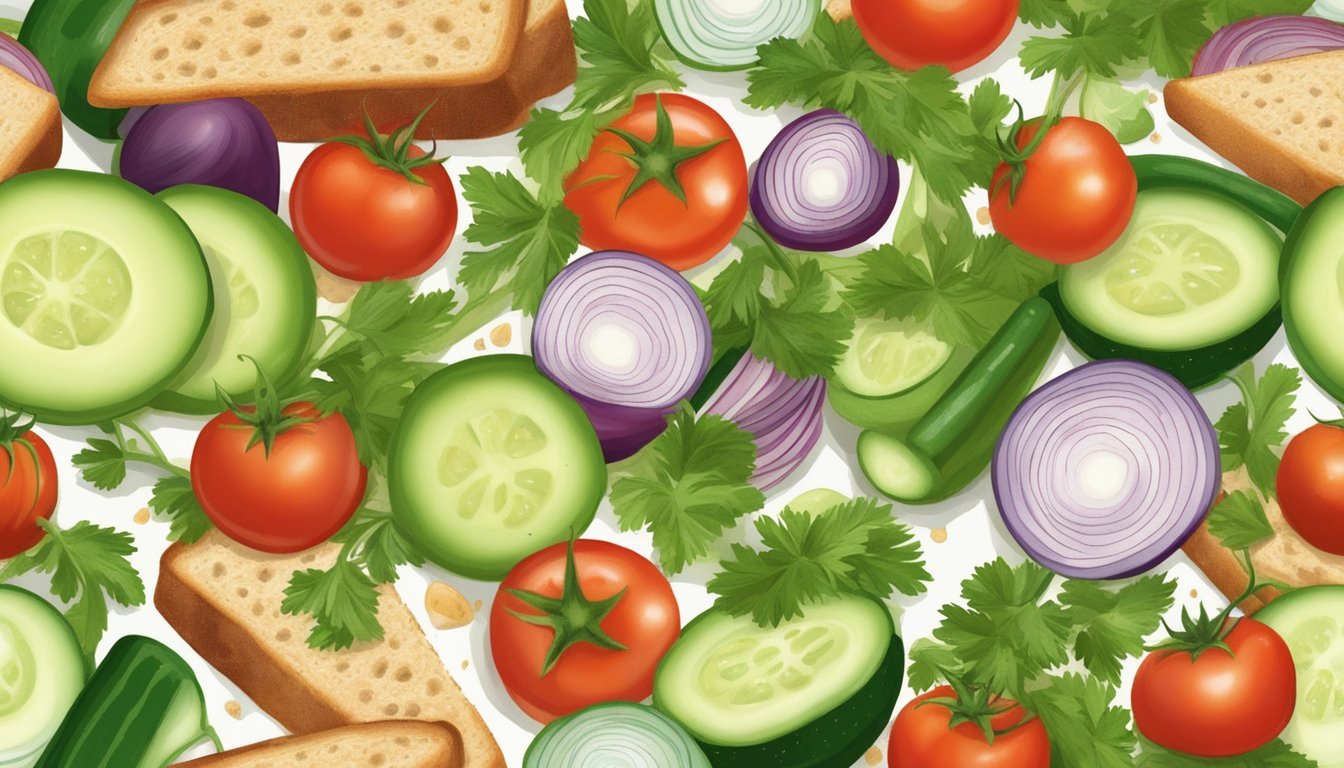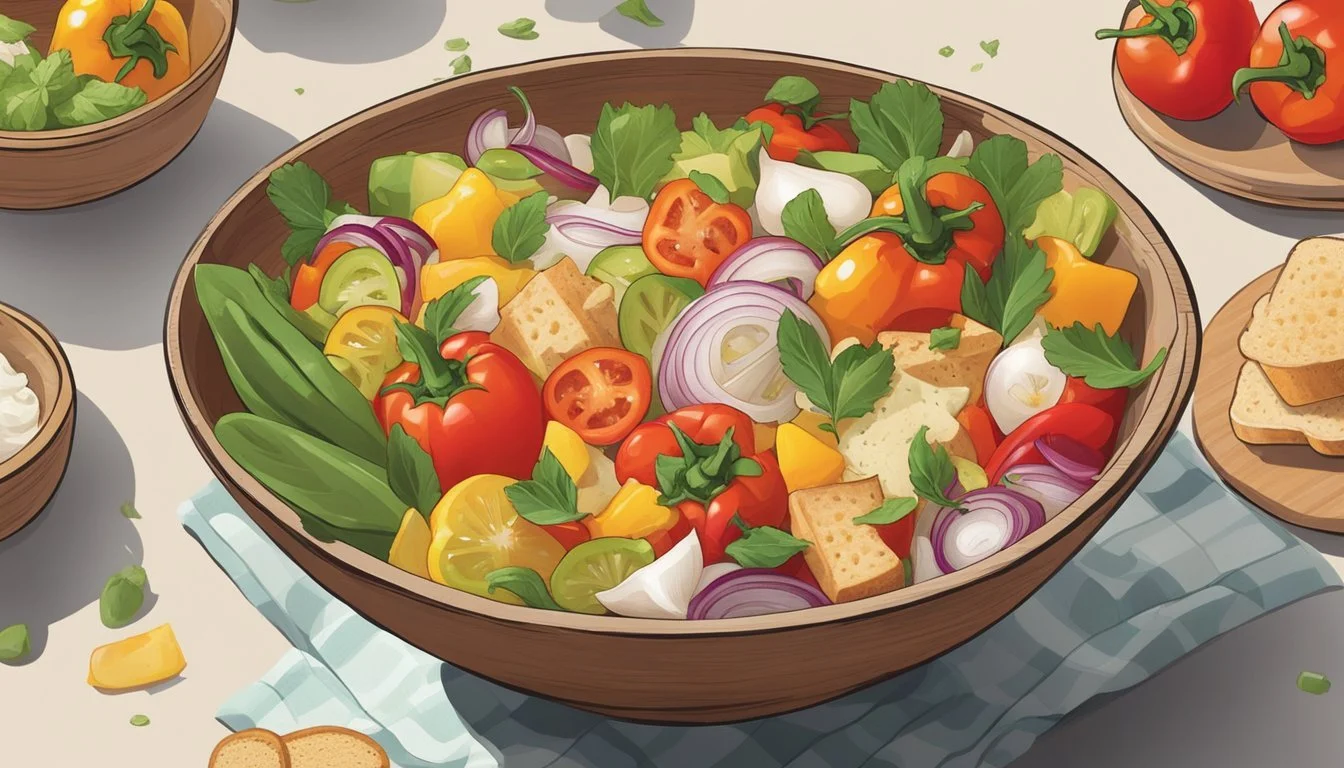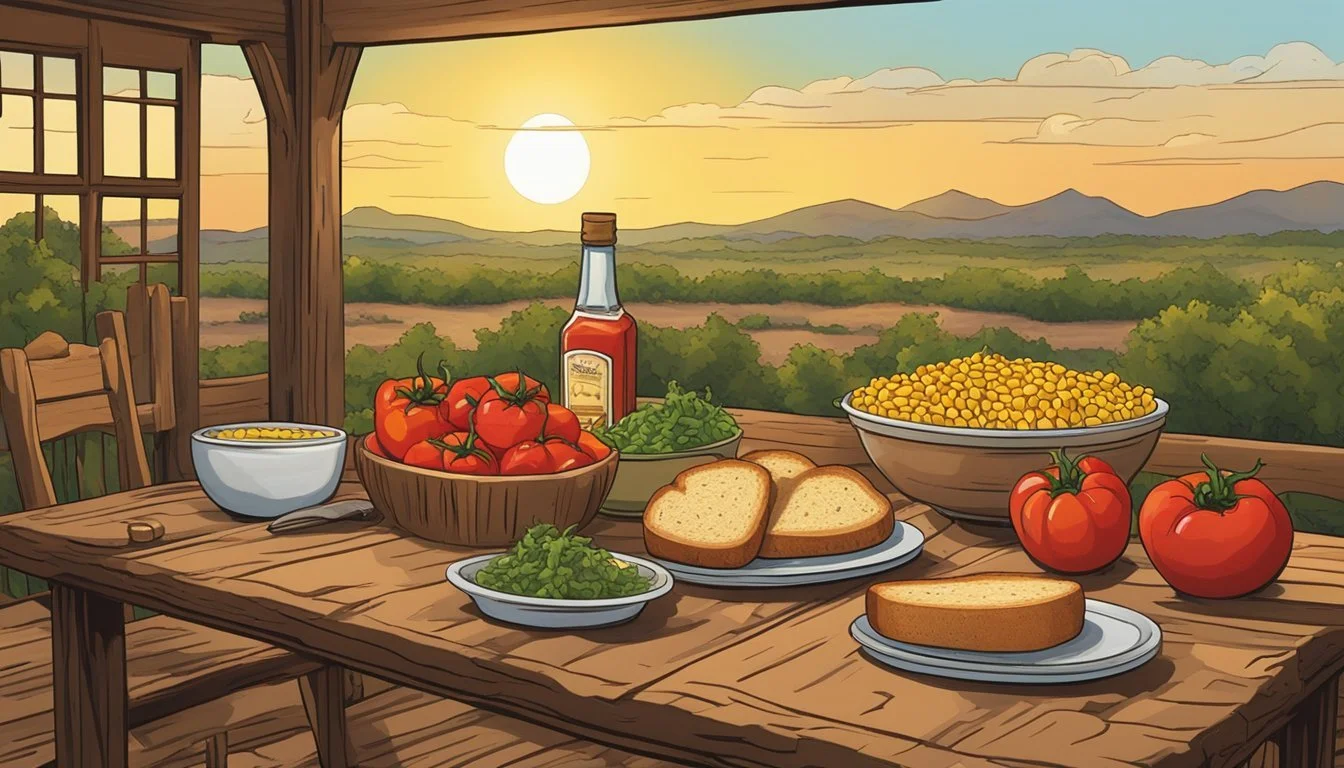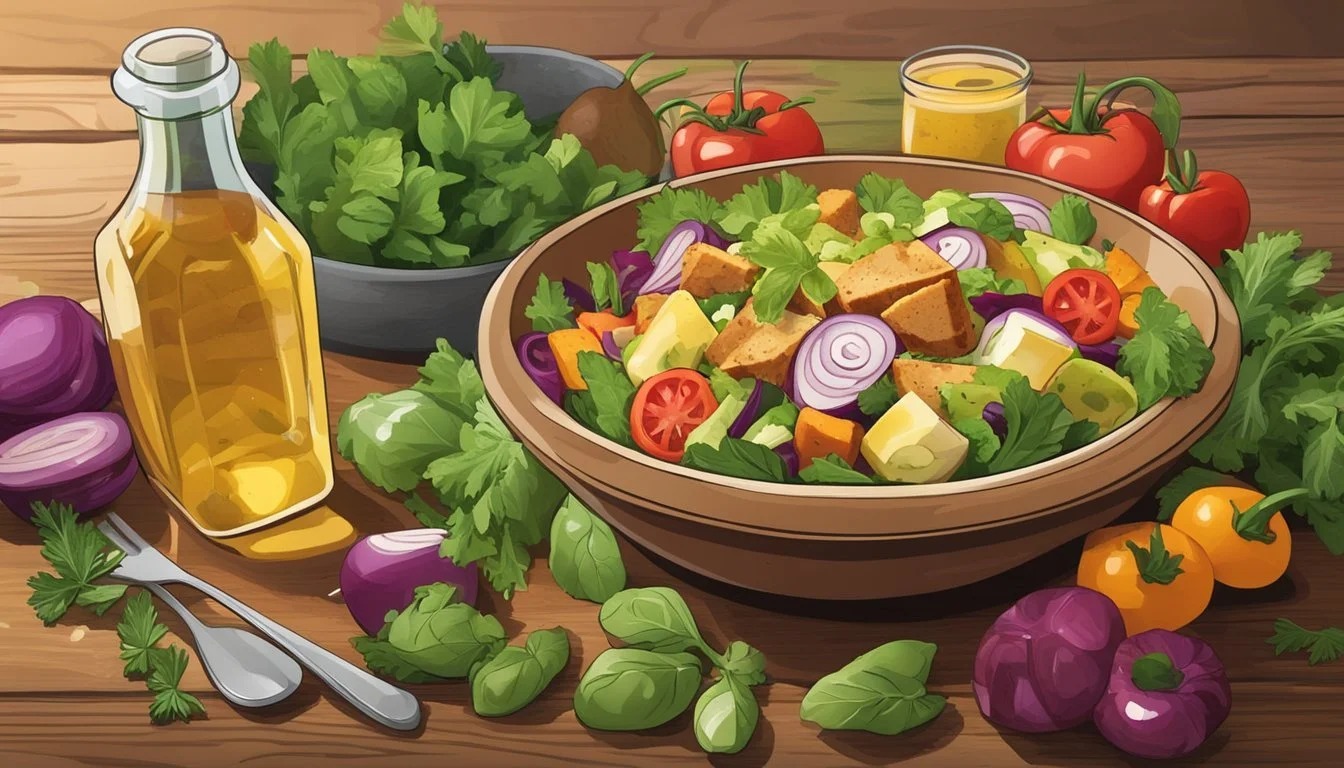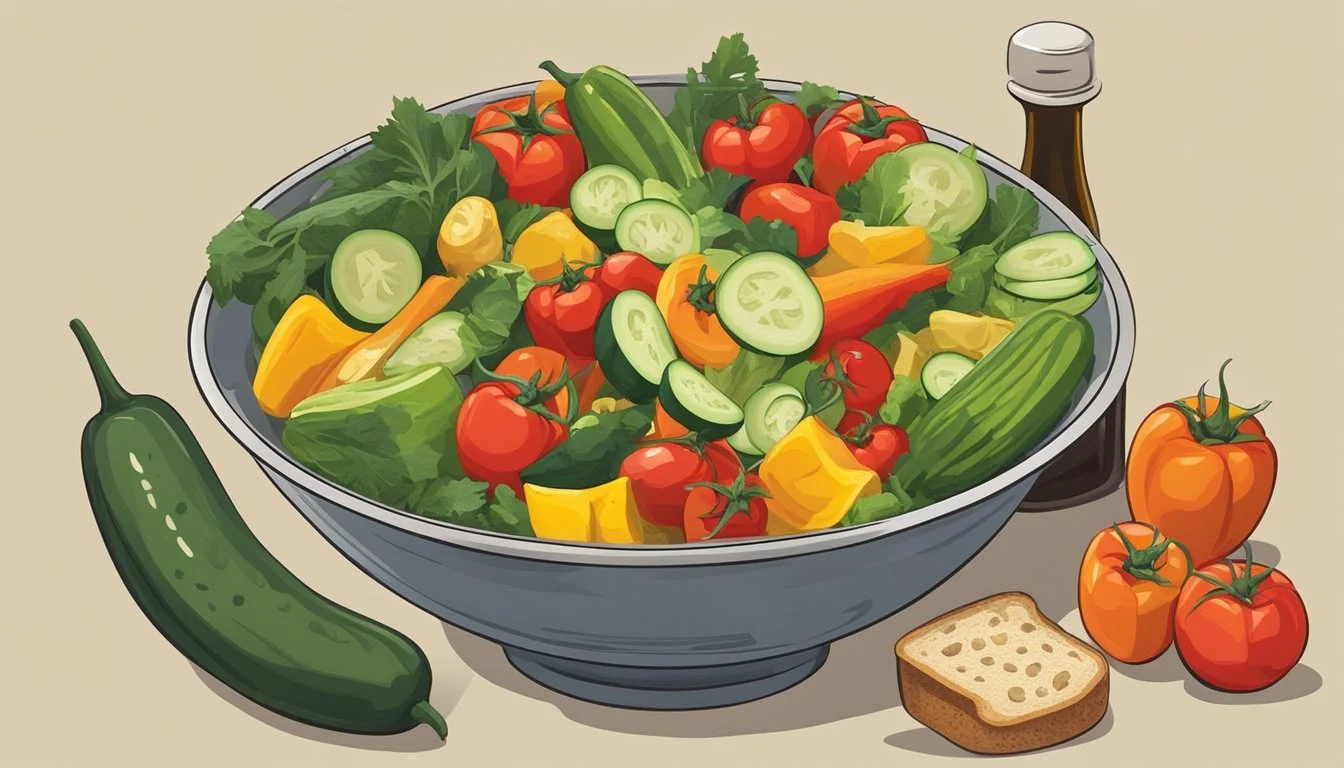How to Make a Texas-Style Panzanella Salad
A Fresh Twist on the Classic
Texas-style Panzanella brings a Southern twist to the traditional Italian bread (What wine goes well with bread?) salad by infusing it with bold flavors typical of Texan cuisine. This reinvention incorporates elements like Cajun-smoked sausage alongside classic ingredients such as tomatoes (What wine goes well with tomatoes?), cucumbers (how long do cucumbers last?), red onions, and of course, chunks of hearty bread. Ideal for those warm Lone Star State summers, a Texas-Style Panzanella is not just a salad; it's a celebration of texture and taste that brings together the old world and the new.
In creating this dish, attention to quality ingredients is paramount. Fresh, ripe heirloom tomatoes meld with crisp English cucumbers and thinly sliced red onions, providing a vibrant base. The addition of smoky sausage elevates the dish, lending a unique depth that is undeniably Texan. To finish, fresh mozzarella and basil add a gentle, creamy contrast to the robust flavors within the salad.
Equally important to the Texas-style Panzanella is the bread, acting as a hearty canvas soaking up the flavors of the dressing. The bread is cubed and toasted until golden brown, ensuring that it retains its texture when tossed with the dressing. A homemade vinaigrette, often starting with the juice of the marinated tomatoes, ties the salad together with a tangy zing. This combination of ingredients and the preparation process yields a salad that is as delicious as it is satisfying, truly embodying the spirit of Texas in every bite.
Overview of Panzanella Salad
Panzanella salad is a rustic Italian dish that epitomizes the ingenious fusion of simplicity and flavor in Italian cuisine. Originating from Tuscany, it is traditionally a summer salad, celebrated for transforming stale bread and ripe tomatoes into a refreshing meal. The salad masterfully combines crusty bread that is often toasted to revitalized crispness and an array of fresh, succulent vegetables.
The core ingredients include:
Crusty bread (typically stale, to avoid sogginess when dressed)
Ripe tomatoes
Cucumbers
Onions
Extra virgin olive oil
Vinegar (commonly red wine vinegar)
Basil leaves and other fresh herbs (how long do fresh herbs last?) are often added to infuse the salad with a vibrant, herbal note. The dressing is a simple vinaigrette, embracing the essence of extra virgin olive oil and vinegar, seasoned to taste. The elements are left to marinate together, which allows the flavors to meld; the bread absorbs the vinaigrette and tomato juices, becoming tender yet maintaining a pleasant chewiness.
The Texas-style variation might include local twists, such as the incorporation of zesty ingredients or a barbecue-inspired dressing. This adaptation, however, remains true to the heart of panzanella salad: a celebration of peak-season produce and resourceful, tasty use of day-old bread.
Panzanella stands out among salads (What wine goes well with salads?) for its ability to serve as both a side dish and a substantial stand-alone meal. Its versatility and ease of preparation make it a beloved choice for gatherings and a testament to the resourcefulness of Italian cuisine.
Ingredients for Texas-Style Panzanella
Crafting a Texas-Style Panzanella involves a careful selection of ingredients that balance traditional Italian elements with Texan flair. Freshness and quality are paramount.
Choosing the Bread
For the foundation of the Panzanella, stale bread provides resilience and absorbs flavors well. A French bread or sourdough, cut into cubes and toasted, delivers a satisfying texture.
Selecting the Vegetables
Key vegetable ingredients include tomatoes and cucumber for juicy freshness. Cherry tomatoes and fresh corn add a sweet burst, while red onions offer a sharp counterpoint. For a Texas twist, one can also add avocado for creaminess.
Proteins and Cheeses
A hearty addition of chicken elevates the salad into a fulfilling meal. Mozzarella cheese or burrata brings silky richness that contrasts well with the other textures.
Herbs and Flavor Enhancers
Fresh basil and oregano are essential herbs for an aromatic lift. Sprinkles of salt and pepper, along with fresh mint, can be added to taste for an extra layer of flavor.
Preparation Techniques
The creation of a Texas-Style Panzanella Salad requires a careful approach to preparing the bread and vegetables to ensure a flavorful and textured result that befits this twist on the classic recipe.
Toasting the Bread
Toasting the bread is a critical step in making Panzanella, as it provides the necessary crunch and a platform to absorb the flavors of the salad. One can either toast the bread in a skillet over medium heat or in an oven. The bread should be cut into cubes and tossed in olive oil before being toasted until golden brown.
Grilling the Vegetables
As a twist on the traditional recipes, grilling the vegetables is essential to infuse a smoky, charred flavor distinctive of Texas cuisine. Bell peppers, onions, and tomatoes should be grilled over medium-high heat until they have a nice char and are tender. The grill squad should turn the vegetables occasionally to ensure even grilling.
Mixing the Ingredients
Once the bread is toasted and the vegetables are grilled, combining all ingredients is done in a large bowl. The mix-ins can include fresh herbs, additional vegetables, or a protein such as grilled chicken. Everything should be tossed gently to distribute the flavors and allow the dressing to coat the bread and vegetables evenly. The salad should sit before serving to let the bread soak up the vinaigrette and flavors from the mix-ins.
Making the Vinaigrette
The creation of a Texas-style Panzanella salad's vinaigrette is pivotal to its flavor profile. It blends the classic components of vinaigrette with Texan-inspired twists for a distinctive finish.
Classic Vinaigrette Components
To begin crafting your vinaigrette, consider the base components that are essential for a balanced dressing. A traditional vinaigrette employs a mixture of oil and vinegar, combined at a 3:1 ratio for optimal emulsification. Extra virgin olive oil is a popular choice for its rich taste and health benefits. As for the vinegar, options include red wine vinegar for a sharp tang or balsamic vinegar for a hint of sweetness. Texture and flavor depth are enhanced with the inclusion of Dijon mustard, and seasoning is essential, typically salt and black pepper.
Ingredients:
3 parts oil (e.g., olive oil)
1 part vinegar (e.g., red wine or balsamic)
Dijon mustard
Salt
Black pepper
Adjusting Acidity and Seasoning
The acidity level of the vinaigrette can be tailored to one's taste preferences. It's crucial to taste and adjust accordingly, adding more vinegar for increased sharpness or oil to mellow it out. Seasoning with salt and pepper should be done gradually while continually tasting to ensure the flavors are balanced without overpowering the salad. Adding a sweet element such as honey or sugar can also counterbalance acidity if desired.
Adjustments:
Incrementally add vinegar for acidity
Introduce more oil to soften sharpness
Season with salt and pepper to taste
Optional: honey or sugar to balance
Innovative Texas Twists
Embrace the spirit of Texas by integrating bold, regional flavors into the vinaigrette. Jalapeños can introduce a spicy element, whether diced fresh or pickled for an added tang. Consider whisking in finely chopped pickles or pickle juice for a surprising twist. Toasted pecans crushed into the dressing not only add a nutty flavor but also create a unique texture reminiscent of Texas cuisine. These unconventional additions convert a classic vinaigrette into a memorable Texas-style dressing that stands out in a Panzanella salad.
Texan Additions:
Jalapeños (fresh or pickled), finely diced
Pickles or pickle juice
Toasted pecans, crushed
In summary, the construction of a Texas-style vinaigrette for Panzanella salad marries classic technique with regional flavors to create a dressing that's both comfortable and daring in its taste profile.
Combining and Serving
When creating a Texas-style Panzanella Salad, the layering of fresh ingredients and the final garnishing stage are essential to providing a visually appealing and flavorful dish.
Layering Salad Elements
A Texas-style Panzanella Salad elevates the traditional Italian recipe by incorporating bold Texan flavors. He or she begins by distributing cubes of day-old, crusty bread as the foundational layer in a large mixing bowl. They ensure the bread has been toasted to provide a satisfying crunch. Next, on top of the bread, the cook adds a colorful assortment of ripe tomatoes, crisp cucumbers, and thinly sliced red onions. Importantly, they include Texas twists such as diced green onions for sharpness, tangy pepperoncini for a distinct pop of flavor, and a sprinkling of shaved Parmesan (shaved parm) for a salty, umami note. Each salad element is thoughtfully layered to ensure every bite offers a harmonious blend of textures and tastes.
Bread cubes
Ripe tomatoes
Crisp cucumbers
Thinly sliced red onions
Diced green onions
Tangy pepperoncini
Shaved Parmesan (shaved parm)
Garnishing for Presentation
The final step of preparing the salad focuses on garnishes that enhance both the aesthetics and taste. One sprinkles a few more green onions and a dash of extra shaved parm over the top for an attractive and flavorful finish. A drizzle of the vinaigrette dressing connects all the layers, ensuring the salad is well-coated and every mouthful bursts with the dressing's zesty flavors. Before presenting it as a side dish or a hearty main course, the cook lets the salad sit, allowing the flavors to meld together and the bread to soak up the dressing, achieving the iconic Panzanella texture.
Sprinkle
Additional green onions
More shaved Parmesan
Drizzle
Vinaigrette dressing
The cook is attentive to serve the Panzanella immediately, maintaining the bread's desired consistency, and offering the best possible dining experience.
Pairings and Serving Suggestions
A Texas-Style Panzanella Salad offers a symphony of flavors and textures that pairs well with a variety of main dishes. Given its bold taste and hearty composition, this salad stands up to the strong flavors of meats and the casual ambiance of a summer cookout.
Burgers: The robustness of a classic American burger complements the tanginess and crunch of the Texas-Style Panzanella Salad. The croutons in the salad will echo the pleasant breadiness of the burger bun, creating a cohesive dining experience.
Steak: An expertly grilled steak is an exquisite match for Panzanella Salad. The smokiness of the meat and the charred, crispy edges create a delightful contrast with the fresh vegetables and zesty dressing of the salad.
For a Summer Cookout: The Texas-Style Panzanella can effortlessly transform into a crowd-pleaser at any summer cookout.
Cookout Main Course Pairing Benefit Grilled Chicken Lightness complements the richness of the Panzanella. Barbecued Pork Ribs (What wine goes well with pork ribs?) Salad's acidity cuts through the pork's fattiness. Grilled Vegetables (What wine goes well with grilled vegetables?) Harmonizes with the salad's garden-fresh ingredients.
As a side dish, the salad serves not just as a complement to the mains, but also as a palate cleanser, with its crisp, vibrant flavors refreshing the taste buds between bites of more savory fare.
Whether used as a bold counterpoint to the simplicity of a burger or as a vibrant complement to a sizzling steak, a Texas-Style Panzanella imbues any meal with the spirit of a summer feast. It offers a great combination of textures and flavors that enhance the overall barbecue experience.
Dietary Variations
Making a Texas-Style Panzanella Salad can be adaptable to varying dietary needs without compromising on the robust flavors characteristic of this dish.
Vegan Variations
To align the recipe with vegan dietary requirements, one can replace any non-vegan ingredients found in the traditional Texas-Style Panzanella Salad. One should use a vegan alternative to cheese, if cheese is included. Vegan cheese can be sourced from nuts or soy. To ensure the dressing is vegan, they should confirm that ingredients like Dijon mustard do not contain honey and opt for a plant-based oil.
Cheese: Swap out traditional cheese with a vegan cheese option.
Dressing: Use vegan-friendly condiments and ensure no honey is involved.
Gluten-Free Adjustments
For a gluten-free version of the salad, the bread is the primary concern. One must choose a gluten-free bread that still maintains a hearty texture to sustain the essence of the salad. The following adjustments can be made:
Bread: Select a high-quality gluten-free bread cut into cubes.
Croutons: If croutons are desired, they should be homemade or store-bought certified gluten-free.
In both cases, the salad should maintain its original flavor profile, ensuring that both the vegan and gluten-free versions are just as enjoyable as the traditional salad.
Storage and Leftovers
When it comes to storing Texas-Style Panzanella Salad, maintaining freshness is crucial. To maximize lifespan, leftovers should promptly go into the fridge within 2 hours of preparation, following food safety guidelines to prevent bacterial growth.
For refrigeration, the salad should be transferred to an airtight container, or it can be covered with plastic wrap in a bowl. When stored properly, the salad will retain its quality for 2-3 days. It's essential to note that as Panzanella includes bread, the texture may soften with time, affecting the salad's characteristic crunch.
Here's a brief guide to storing the salad:
Cool quickly: Allow the salad to cool down to room temperature before refrigerating.
Separate Dressing (if possible): To retain the bread's texture, store the dressing separately and add just before serving.
Container: Select a container that is just the right size to minimize air exposure.
Monitoring Freshness:
Visual Check: Look for any signs of moisture or sogginess in the bread.
Smell Test: An off smell is indicative that the salad may not be safe to eat.
Taste: If the salad passes both visual check and smell test, taste a small piece to decide whether it's still enjoyable.
One should always use their best judgment when consuming leftovers, considering both food safety and quality. If the salad appears or smells questionable, it is best to err on the side of caution and discard it.
Nutritional Information
A Texas-Style Panzanella Salad combines nutritious ingredients such as vegetables, bread, and a light dressing. The nutritional content can vary depending on the specific recipe and portion sizes, but here is a general breakdown to guide those interested in the dietary information of this dish.
Nutrient Approximate Amount Calories 350-450 per serving Protein 10-15g per serving Fat 15-25g per serving Carbohydrates 30-40g per serving Dietary Fiber 4-6g per serving
Calories: A serving of Texas-Style Panzanella Salad typically contains between 350-450 calories. The bread contributes a significant part of the calorie content, but using whole grain bread can offer more nutrients and fiber.
Dietary Information: This salad is a source of several nutrients. The vegetables like tomatoes, cucumber, and onions provide vitamins and minerals while the bread cubes supply complex carbohydrates for energy. Olive oil in the dressing, while calorie-dense, offers healthy monounsaturated fats that can support heart health.
The cheese and any meat additions will modify the nutritional content, often adding protein but also fat and calories. For a lower-calorie version, one can reduce the amount of bread and oil, or substitute some ingredients with lower-calorie alternatives, such as low-fat cheese.
It is important to consider the types of ingredients used as they can affect the overall healthiness of the dish. For those adhering to gluten-free dietary restrictions, gluten-free bread can be used to maintain the integrity of the recipe. Additionally, the salad can be adjusted to fit vegetarian or vegan diets by omitting or substituting cheese and any meat products with plant-based options.
Food Safety and Allergens
When preparing Texas-Style Panzanella Salad, it is crucial to consider food safety and identify common allergens to ensure that it is suitable for all guests.
Food Safety:
Cross-Contamination: Always use separate cutting boards and utensils for different ingredients, particularly if handling raw meats or dairy alongside raw vegetables.
Produce: Fresh produce should be rinsed thoroughly to remove potential contaminants, such as bacteria or pesticides.
Storage: Store the salad at a safe temperature before serving. If the salad sits out at room temperature for more than two hours, it is no longer safe to consume.
Common Allergens:
Gluten: Traditional Panzanella includes bread cubes, which normally contain gluten. For gluten-sensitive individuals, use gluten-free bread as an alternative.
Dairy: If cheese is added to the salad, it could be an allergen for those with lactose intolerance or a dairy allergy. Offer a dairy-free variant or clearly label the dish if it contains dairy.
Nuts: Some recipes include nuts for added crunch. Clearly label the dish if nuts are used to prevent allergic reactions.
Lastly, it's important to consider the privacy of guests with food allergies. Respect their privacy by not publicly announcing their dietary restrictions. Instead, display clearly written labels or directly inform concerned individuals about the ingredients.
To ensure safety and enjoyment for all, chefs should remain vigilant and transparent about their Texas-Style Panzanella Salad's ingredients and preparation.

